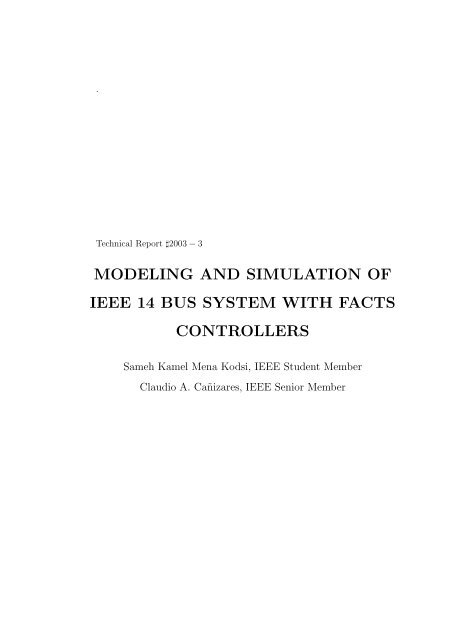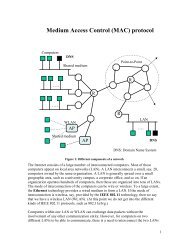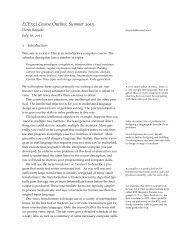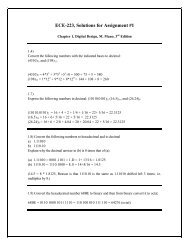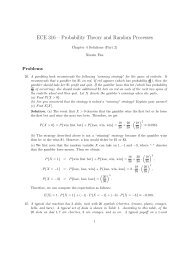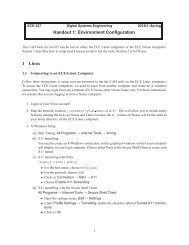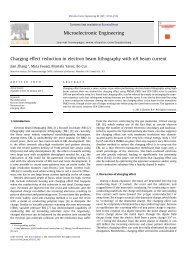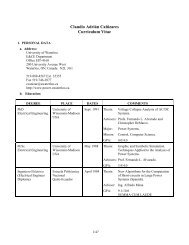Modeling and Simulation of IEEE 14-bus System - Electrical and ...
Modeling and Simulation of IEEE 14-bus System - Electrical and ...
Modeling and Simulation of IEEE 14-bus System - Electrical and ...
You also want an ePaper? Increase the reach of your titles
YUMPU automatically turns print PDFs into web optimized ePapers that Google loves.
.<br />
Technical Report ♯2003 − 3<br />
MODELING AND SIMULATION OF<br />
<strong>IEEE</strong> <strong>14</strong> BUS SYSTEM WITH FACTS<br />
CONTROLLERS<br />
Sameh Kamel Mena Kodsi, <strong>IEEE</strong> Student Member<br />
Claudio A. Cañizares, <strong>IEEE</strong> Senior Member
ABSTRACT<br />
This report covers the modeling <strong>of</strong> the st<strong>and</strong>ard <strong>IEEE</strong> <strong>14</strong> <strong>bus</strong> system using the<br />
Power <strong>System</strong> Toolbox (PST) package. The basic system is tested under large <strong>and</strong><br />
small disturbances to study the dynamic behavior <strong>of</strong> the system <strong>and</strong> the stability<br />
margins associated with the different configurations <strong>of</strong> the system.<br />
As a suggested solution to increase stability margins <strong>of</strong> the system, FACTS<br />
controllers are added, modeled <strong>and</strong> tested to show the effect <strong>of</strong> these controllers on<br />
the different stability margins under both large <strong>and</strong> small disturbances.<br />
1
Contents<br />
1 BLOCK DIAGRAM MODELING 1<br />
1.1 Introduction . . . . . . . . . . . . . . . . . . . . . . . . . . . . . . . 1<br />
1.2 <strong>System</strong> Models . . . . . . . . . . . . . . . . . . . . . . . . . . . . . 3<br />
1.2.1 Synchronous Generators Model . . . . . . . . . . . . . . . . 3<br />
1.2.2 Load Models . . . . . . . . . . . . . . . . . . . . . . . . . . 4<br />
1.2.3 Power <strong>System</strong> Stabilizer PSS Model . . . . . . . . . . . . . . 8<br />
1.2.4 FACTS Controllers Models . . . . . . . . . . . . . . . . . . . 9<br />
2 TOOLS AND SIMULATION RESULTS 16<br />
2.1 Introduction . . . . . . . . . . . . . . . . . . . . . . . . . . . . . . . 16<br />
2.2 Tools . . . . . . . . . . . . . . . . . . . . . . . . . . . . . . . . . . . 17<br />
2.3 <strong>Simulation</strong> Results . . . . . . . . . . . . . . . . . . . . . . . . . . . 17<br />
2.3.1 Base Test <strong>System</strong> Performance . . . . . . . . . . . . . . . . 17<br />
2.3.2 Effect <strong>of</strong> PSS Controller . . . . . . . . . . . . . . . . . . . . 22<br />
2.3.3 Effect <strong>of</strong> SVC Controller . . . . . . . . . . . . . . . . . . . . 22<br />
2
2.3.4 Effect <strong>of</strong> TCSC Controller . . . . . . . . . . . . . . . . . . . 27<br />
2.3.5 Controller Interactions Among TCSCs <strong>and</strong> PSSs . . . . . . . 32<br />
A <strong>IEEE</strong> <strong>14</strong>-BUS TEST SYSTEM 37<br />
B DATA <strong>of</strong> the Controllers 41<br />
B.1 PSS Data . . . . . . . . . . . . . . . . . . . . . . . . . . . . . . . . 41<br />
B.2 SVC Data . . . . . . . . . . . . . . . . . . . . . . . . . . . . . . . . 41<br />
B.3 TCSC Data . . . . . . . . . . . . . . . . . . . . . . . . . . . . . . . 42<br />
Bibliography 43<br />
3
List <strong>of</strong> Figures<br />
1.1 <strong>IEEE</strong> <strong>14</strong>-<strong>bus</strong> test system. . . . . . . . . . . . . . . . . . . . . . . . . 2<br />
1.2 <strong>IEEE</strong> <strong>14</strong>-<strong>bus</strong> test system with different controllers. . . . . . . . . . . 3<br />
1.3 Subtransient model for the synchronous generator in the direct <strong>and</strong><br />
quadrature. . . . . . . . . . . . . . . . . . . . . . . . . . . . . . . . 5<br />
1.4 Rearranged block diagram for the subtransient machine model. . . . 6<br />
1.5 Block diagram for computation <strong>of</strong> torque <strong>and</strong> speed in the subtran-<br />
sient machine model. . . . . . . . . . . . . . . . . . . . . . . . . . . 6<br />
1.6 AVR <strong>and</strong> exciter model for synchronous generator. . . . . . . . . . 7<br />
1.7 Basic block PSS diagram. . . . . . . . . . . . . . . . . . . . . . . . 9<br />
1.8 Basic SVC structure with voltage control. . . . . . . . . . . . . . . 10<br />
1.9 Typical steady-state voltage control characteristic <strong>of</strong> an SVC. . . . 11<br />
1.10 Block diagram <strong>of</strong> an SVC used in PST. . . . . . . . . . . . . . . . . 11<br />
1.11 Basic TCSC structure with current control. . . . . . . . . . . . . . . 12<br />
1.12 TCSC V-I steady state characteristics. . . . . . . . . . . . . . . . . 13<br />
1.13 TCSC model for stability studies. . . . . . . . . . . . . . . . . . . . 15<br />
4
1.<strong>14</strong> Block diagram <strong>of</strong> the TCSC stability control loop. . . . . . . . . . . 15<br />
2.1 P-V curves at <strong>bus</strong> <strong>14</strong> for different contingencies for the <strong>IEEE</strong> <strong>14</strong>-<strong>bus</strong><br />
test system. . . . . . . . . . . . . . . . . . . . . . . . . . . . . . . . 19<br />
2.2 Eigenvalues for the line 2-4 outage in the <strong>IEEE</strong> <strong>14</strong>-<strong>bus</strong> test system<br />
at λ=0.4. . . . . . . . . . . . . . . . . . . . . . . . . . . . . . . . . 20<br />
2.3 Generator speed oscillation due to Hopf bifurcation triggered by line<br />
2-4 outage at λ=0.4 . . . . . . . . . . . . . . . . . . . . . . . . . . . 21<br />
2.4 P-V curves at <strong>bus</strong> <strong>14</strong> for different contingencies for the <strong>IEEE</strong> <strong>14</strong>-<strong>bus</strong><br />
test system with a PSS at <strong>bus</strong> 1. . . . . . . . . . . . . . . . . . . . 23<br />
2.5 Some eigenvalues with PSS at <strong>bus</strong> 1 for a line 2-4 outage in the <strong>IEEE</strong><br />
<strong>14</strong>-<strong>bus</strong> test system. . . . . . . . . . . . . . . . . . . . . . . . . . . . 24<br />
2.6 Generator speed oscillation with PSS at <strong>bus</strong> 1 for a line 2-4 outage<br />
in the <strong>IEEE</strong> <strong>14</strong>-<strong>bus</strong> test system. . . . . . . . . . . . . . . . . . . . . 25<br />
2.7 P-V curves at <strong>bus</strong> 13 for different contingencies in the <strong>IEEE</strong> <strong>14</strong>-<strong>bus</strong><br />
test system with a SVC at <strong>bus</strong> <strong>14</strong>. . . . . . . . . . . . . . . . . . . . 26<br />
2.8 Some eigenvalues with a SVC at <strong>bus</strong> <strong>14</strong> for a line 2-4 outage in the<br />
<strong>IEEE</strong> <strong>14</strong>-<strong>bus</strong> test system for λ = 0.4. . . . . . . . . . . . . . . . . . 27<br />
2.9 Generator speed oscillation with a SVC at <strong>bus</strong> <strong>14</strong> for a line 2-4 outage<br />
in the <strong>IEEE</strong> <strong>14</strong>-<strong>bus</strong> test system for λ = 0.4. . . . . . . . . . . . . . 28<br />
2.10 P-V curves at <strong>bus</strong> <strong>14</strong> for different contingencies for <strong>IEEE</strong> <strong>14</strong>-<strong>bus</strong> test<br />
system with a TCSC in line 4-5. . . . . . . . . . . . . . . . . . . . . 29<br />
2.11 Some eigenvalues for the <strong>IEEE</strong> <strong>14</strong>-<strong>bus</strong> test system with a TCSC in<br />
line 4-5 for line 2-4 outage. . . . . . . . . . . . . . . . . . . . . . . . 30<br />
5
2.12 Oscillation damping in the <strong>IEEE</strong> <strong>14</strong>-<strong>bus</strong> test system with a TCSC<br />
in line 4-5 for a line 2-4 outage. . . . . . . . . . . . . . . . . . . . . 31<br />
2.13 Some eigenvalues for the system with PSS controller (KPSS =5) <strong>and</strong><br />
TCSC controller for a line 2-4 outage λ =0.4. . . . . . . . . . . . . 33<br />
2.<strong>14</strong> Some eigenvalues for the system with PSS controller only (KPSS =7)<br />
for a line 2-4 outage at λ =0.4. . . . . . . . . . . . . . . . . . . . . 34<br />
2.15 Some eigenvalues for the system with PSS controller (KPSS =7) <strong>and</strong><br />
TCSC controller for a line 2-4 outage at λ =0.4. . . . . . . . . . . . 35<br />
2.16 Oscillation damping in the <strong>IEEE</strong> <strong>14</strong>-<strong>bus</strong> test system with PSS con-<br />
troller (KPSS =7) <strong>and</strong> TCSC controller for line 2-4 outage at λ =0.4. 36<br />
6
List <strong>of</strong> Tables<br />
2.1 Dynamic <strong>and</strong> Static Loading Margins for Base Test <strong>System</strong> . . . . . 18<br />
2.2 Dynamic <strong>and</strong> Static Loading Margins for the Test <strong>System</strong> with SVC<br />
Controller . . . . . . . . . . . . . . . . . . . . . . . . . . . . . . . . 23<br />
2.3 Dynamic <strong>and</strong> Static Loading Margins for the Test <strong>System</strong> with TCSC<br />
Controller . . . . . . . . . . . . . . . . . . . . . . . . . . . . . . . . 30<br />
A.1 Exciter data . . . . . . . . . . . . . . . . . . . . . . . . . . . . . . . 37<br />
A.2 Generator data . . . . . . . . . . . . . . . . . . . . . . . . . . . . . 38<br />
A.3 Bus data . . . . . . . . . . . . . . . . . . . . . . . . . . . . . . . . . 39<br />
A.4 Line Data . . . . . . . . . . . . . . . . . . . . . . . . . . . . . . . . 40<br />
B.1 PSS controller parameters used in the PST s<strong>of</strong>tware . . . . . . . . . 41<br />
B.2 SVC static data . . . . . . . . . . . . . . . . . . . . . . . . . . . . . 41<br />
B.3 SVC controller parameters used in the PST s<strong>of</strong>tware . . . . . . . . 42<br />
B.4 TCSC static data . . . . . . . . . . . . . . . . . . . . . . . . . . . . 42<br />
B.5 TCSC controller parameters used in the PST s<strong>of</strong>tware . . . . . . . . 42<br />
7
Chapter 1<br />
BLOCK DIAGRAM MODELING<br />
1.1 Introduction<br />
A single line diagram <strong>of</strong> the <strong>IEEE</strong> <strong>14</strong>-<strong>bus</strong> st<strong>and</strong>ard system extracted from [1] is<br />
shown in Figure 1.1. It consists <strong>of</strong> five synchronous machines with <strong>IEEE</strong> type-1<br />
exciters, three <strong>of</strong> which are synchronous compensators used only for reactive power<br />
support. There are 11 loads in the system totaling 259 MW <strong>and</strong> 81.3 Mvar. The<br />
dynamic data for the generators exciters was selected from [2].<br />
The <strong>IEEE</strong> <strong>14</strong>-BUS was studied using the UWPFLOW <strong>and</strong> PST programs to<br />
obtain the system P-V curves <strong>and</strong> perform time domain <strong>and</strong> eigenvalue analyses to<br />
study the general performance <strong>of</strong> the system. SVC, TCSC <strong>and</strong> PSS controllers were<br />
also added to the system, as shown in Figure 1.2, to study their effect in the system<br />
<strong>and</strong> their interactions. The model details are discussed in the following sections,<br />
<strong>and</strong> the corresponding data is given in Appendices A <strong>and</strong> B.<br />
1
CHAPTER 1. BLOCK DIAGRAM MODELING 2<br />
G<br />
C<br />
GENERATORS<br />
SYNCHRONOUS<br />
COMPENSATORS<br />
G<br />
1<br />
THREE WINDING<br />
12<br />
G<br />
TRANSFORMER EQUIVALENT<br />
7<br />
9<br />
4<br />
8<br />
C<br />
C<br />
2<br />
13<br />
11<br />
Figure 1.1: <strong>IEEE</strong> <strong>14</strong>-<strong>bus</strong> test system.<br />
5<br />
6<br />
10<br />
<strong>14</strong><br />
C<br />
3<br />
7<br />
9<br />
4<br />
C<br />
8
CHAPTER 1. BLOCK DIAGRAM MODELING 3<br />
G<br />
C<br />
Gen. 1<br />
GENERATORS<br />
SYNCHRONOUS<br />
COMPENSATORS<br />
G<br />
1<br />
PSS<br />
12<br />
G<br />
Gen. 4<br />
C<br />
Gen. 2<br />
2<br />
5<br />
13<br />
11<br />
6<br />
TCSC<br />
SVC<br />
10<br />
<strong>14</strong><br />
C<br />
3<br />
Gen. 3<br />
9<br />
7 8<br />
Figure 1.2: <strong>IEEE</strong> <strong>14</strong>-<strong>bus</strong> test system with different controllers.<br />
The detailed data <strong>of</strong> the system is shown in Appendix A.<br />
1.2 <strong>System</strong> Models<br />
1.2.1 Synchronous Generators Model<br />
4<br />
C<br />
Gen. 5<br />
Mathematical models <strong>of</strong> a synchronous machine vary from elementary classical<br />
models to more detailed ones. In the detailed models, transient <strong>and</strong> subtransient
CHAPTER 1. BLOCK DIAGRAM MODELING 4<br />
phenomena are considered [3, 4]. In the PST program, the subtransient detailed<br />
models are used to represent the machines in the system as depicted in Figure 1.3<br />
[5].<br />
This model is rearranged as shown in Figure 1.4 [6], illustrating the relation be-<br />
tween the equivalent circuit subtransient variables. The following equations link the<br />
mechanical variables with the electrical variables, <strong>and</strong> result in the block diagram<br />
representation depicted in Figure 1.5:<br />
(D + τjS) = Tm − (E ′′ q Iq + E ′′ d Id)<br />
Sδ = ω − 1<br />
(1.1)<br />
where D <strong>and</strong> τj represent the damping constant <strong>and</strong> the inertia time constant,<br />
respectively; Tm st<strong>and</strong>s for the input mechanical torque; ω <strong>and</strong> δ represent the<br />
rotational speed <strong>and</strong> rotor angle, respectively; E ′′ d <strong>and</strong> E ′′ q correspond to the sub-<br />
transient generated voltage in the direct <strong>and</strong> quadrature axes, <strong>and</strong> Id <strong>and</strong> Iq st<strong>and</strong><br />
for the armature current in the direct <strong>and</strong> quadrature axes.<br />
For eigenvalue or time domain simulation studies, it is necessary to include the<br />
effects <strong>of</strong> the excitation controller, which indirectly controls the reactive output <strong>of</strong><br />
a generator. A simple Automatic Voltage Regulator (AVR) model is used in PST<br />
to represent the excitation control <strong>of</strong> generators, as shown in Figure 1.6 [6].<br />
1.2.2 Load Models<br />
The modeling <strong>of</strong> loads in stability studies is a complex problem due to the unclear<br />
nature <strong>of</strong> aggregated loads (e.g. a mix <strong>of</strong> fluorescent, compact fluorescent, inc<strong>and</strong>es-<br />
cent lamps, refrigerators, heater, motor, etc.). Load models are typically classified<br />
into two broad categories: static <strong>and</strong> dynamic. The loads can be modeled using
CHAPTER 1. BLOCK DIAGRAM MODELING 5<br />
E<br />
+<br />
d l<br />
d l<br />
fd E’<br />
Σ q Σ Ψkd (X’ d - X" d )<br />
Σ<br />
-<br />
E’<br />
Field Current<br />
1<br />
s T’<br />
qo<br />
OC<br />
SAT<br />
+<br />
s T’ do<br />
+<br />
d d<br />
+<br />
+<br />
-<br />
( X’ - X" )( X - X’ )<br />
d<br />
d<br />
( X’ - X )<br />
Σ Σ<br />
-E’ d<br />
+<br />
l<br />
-<br />
d<br />
( X" - X )<br />
(X’ - X )<br />
1 1<br />
+<br />
( X’ - X )<br />
+<br />
-<br />
( X’ - X" )( X - X’ )<br />
q<br />
q<br />
q l<br />
Σ<br />
Σ<br />
q<br />
+<br />
-<br />
q<br />
( X" - X )<br />
q<br />
q<br />
(X’ - X )<br />
1<br />
1 + s T"<br />
l<br />
1 + s T"<br />
l<br />
qo<br />
do d l<br />
(X’ - X" )(X - X’ )<br />
d d d d<br />
( X’ - X )<br />
d l<br />
( X" d - X ) l (X d- X’ d)<br />
X’ - X<br />
Ψ<br />
(X’ q - X" q)(X<br />
q-<br />
X’ q)<br />
( X’ - X )<br />
( X" q-<br />
X ) l (X - q X’ q)<br />
X’ - X<br />
q<br />
kq<br />
q<br />
d<br />
l<br />
l<br />
q<br />
l<br />
q<br />
( X’ - X )<br />
(X’ - X" )<br />
q<br />
( X’ - X )<br />
l<br />
X’ - X<br />
X’ - X<br />
q<br />
d l<br />
l<br />
+<br />
+ +<br />
Figure 1.3: Subtransient model for the synchronous generator in the direct <strong>and</strong><br />
quadrature.<br />
X"<br />
Σ<br />
X"<br />
q<br />
d<br />
+<br />
+<br />
+<br />
Ψ<br />
Ψ<br />
d<br />
i d<br />
q<br />
i<br />
q
CHAPTER 1. BLOCK DIAGRAM MODELING 6<br />
I<br />
I<br />
I<br />
q<br />
I<br />
E<br />
d<br />
E"<br />
d<br />
q<br />
d<br />
E"<br />
q<br />
fd<br />
x<br />
xd<br />
- (x - x" )<br />
q<br />
q<br />
+<br />
+<br />
+<br />
Σ<br />
Σ<br />
x’ d - xl<br />
+<br />
+<br />
−<br />
+ +<br />
Σ<br />
Σ<br />
1<br />
1 + T" s<br />
qo<br />
K<br />
d<br />
1<br />
1 + T’ s<br />
K<br />
d<br />
do<br />
1<br />
1 + T" s<br />
Figure 1.4: Rearranged block diagram for the subtransient machine model.<br />
+<br />
+<br />
+<br />
X<br />
X<br />
+<br />
+<br />
+<br />
Σ<br />
T<br />
m<br />
1.0<br />
-<br />
+<br />
T<br />
- +<br />
do<br />
1<br />
D + T s<br />
Figure 1.5: Block diagram for computation <strong>of</strong> torque <strong>and</strong> speed in the subtransient<br />
machine model.<br />
Σ<br />
Σ<br />
e<br />
1 s<br />
j<br />
E"<br />
d<br />
+<br />
+<br />
K<br />
Σ<br />
K<br />
1<br />
2<br />
E"<br />
δ<br />
q<br />
ω
CHAPTER 1. BLOCK DIAGRAM MODELING 7<br />
V<br />
TR<br />
1<br />
1 + s T<br />
R<br />
+<br />
− +<br />
Σ<br />
V −<br />
FB<br />
VREF<br />
V S (PSS)<br />
1 + s T<br />
1 + s T<br />
s K<br />
F<br />
1 + s T<br />
B<br />
F<br />
C<br />
K A<br />
1 + s T<br />
V<br />
Rmin<br />
V<br />
A<br />
Rmax<br />
+<br />
Σ<br />
VR<br />
−<br />
1<br />
s T<br />
S E+<br />
KE<br />
Figure 1.6: AVR <strong>and</strong> exciter model for synchronous generator.<br />
constant impedance, constant current <strong>and</strong> constant power static load models [7].<br />
Thus,<br />
1. Constant Impedance Load Model (constant Z): A static load model where the<br />
real <strong>and</strong> reactive power is proportional to the square <strong>of</strong> the voltage magnitude.<br />
It is also referred to constant admittance load model.<br />
2. Constant Current Load Model (constant I): A static load model where the<br />
real <strong>and</strong> reactive power is directly proportional to the voltage magnitude.<br />
3. Constant Power Load Model (constant PQ): A static load model where the<br />
real <strong>and</strong> reactive powers have no relation to the voltage magnitude. It is also<br />
referred a constant MVA load model.<br />
All these load models can be described by the following polynomial equations:<br />
a V<br />
P =P0<br />
V0<br />
b (1.2)<br />
V<br />
Q =Q0<br />
V0<br />
E<br />
E<br />
fd
CHAPTER 1. BLOCK DIAGRAM MODELING 8<br />
where P0 <strong>and</strong> Q0 st<strong>and</strong> for the real <strong>and</strong> reactive powers consumed at a reference<br />
voltage V0. The exponents a <strong>and</strong> b depend on the type <strong>of</strong> load that is being<br />
represented, e.g. for constant power load models a = b = 0, for constant current<br />
load models a = b = 1 <strong>and</strong> for constant impedance load models a = b = 2.<br />
In power flow studies <strong>and</strong> to obtain the corresponding P-V curves, the loads<br />
are typically represented as constant PQ loads with constant power factor, <strong>and</strong><br />
increased according to:<br />
PL = PLo(1 + λ)<br />
QL = QLo(1 + λ)<br />
(1.3)<br />
where PLo <strong>and</strong> QLo are the initial real <strong>and</strong> reactive power respectively <strong>and</strong> λ is a<br />
p.u. loading factor, which represents a slow varying parameter typically used in<br />
voltage stability studies.<br />
1.2.3 Power <strong>System</strong> Stabilizer PSS Model<br />
A PSS can be viewed as an additional control block used to enhance the system<br />
stability [6]. This block is added to the AVR, <strong>and</strong> uses stabilizing feedback signals<br />
such as shaft speed, terminal frequency <strong>and</strong>/or power to change the input signal <strong>of</strong><br />
the AVR.<br />
The three basic blocks <strong>of</strong> a typical PSS model, are illustrated in Figure 1.7. The<br />
first block is the stabilizer Gain block, which determines the amount <strong>of</strong> damping.<br />
The second is the Washout block, which serves as a high-pass filter, with a time<br />
constant that allows the signal associated with oscillations in rotor speed to pass<br />
unchanged, but does not allow the steady state changes to modify the terminal<br />
voltages. The last one is the phase-compensation block, which provides the desired
CHAPTER 1. BLOCK DIAGRAM MODELING 9<br />
Rotor Speed<br />
Deviation<br />
Gain<br />
K PSS<br />
Washout Filter<br />
ST W<br />
1 + ST W<br />
1 + ST 1<br />
1 + ST 2<br />
Lead / Lag<br />
Figure 1.7: Basic block PSS diagram.<br />
1 + ST 3<br />
1 + ST 4<br />
V smin<br />
V smax<br />
phase-lead characteristic to compensate for the phase lag between the AVR input<br />
<strong>and</strong> the generator electrical (air-gap) torque; in practice, two or more first-order<br />
blocks may be used to achieve the desired phase compensation.<br />
1.2.4 FACTS Controllers Models<br />
FACTS controllers are a family <strong>of</strong> electronic controllers used to enhance power<br />
system performance [8]. Certain FACTS controllers have already been applied <strong>and</strong><br />
others are under development. In particular, SVC, TCSC, STATCOM, SSSC <strong>and</strong><br />
UPFC (a combination <strong>of</strong> a SSSC <strong>and</strong> a STATCOM) are the best known FACTS<br />
controllers [9, 10, 11, 12, 13, <strong>14</strong>, 15]. A brief description regarding the SVC <strong>and</strong><br />
TCSC models used follows.<br />
SVC<br />
The main job <strong>of</strong> a SVC is to inject a controlled capacitive or inductive current so<br />
as to maintain or control a specific variable, mainly <strong>bus</strong> voltage [8]. A well-known<br />
configuration <strong>of</strong> a SVC are the Fixed Capacitor (FC) with Thyristor Controlled<br />
reactor (TCR), <strong>and</strong> Thyristor Switched Capacitor (TSC) with TCR. Figures 1.8<br />
V s
CHAPTER 1. BLOCK DIAGRAM MODELING 10<br />
V ref<br />
Magnitude<br />
Zero<br />
Crossing<br />
Controller<br />
Switching<br />
Logic<br />
α<br />
V<br />
L<br />
V i<br />
I<br />
C<br />
a:1<br />
Filters<br />
Figure 1.8: Basic SVC structure with voltage control.<br />
<strong>and</strong> 1.9 show a basic structure <strong>of</strong> a SVC with voltage control <strong>and</strong> its steady state<br />
control characteristic, respectively, for an FC-TCR type SVC [16].<br />
The SVC is typically modeled using a variable reactance with maximum induc-<br />
tive <strong>and</strong> capacitive limits (see Figure 1.10), which directly correspond to the limits<br />
in the firing angles <strong>of</strong> the thyristors. In addition to the main job <strong>of</strong> the SVC con-<br />
troller, which is to control the SVC <strong>bus</strong> voltage, the reactance <strong>of</strong> the SVC controller<br />
maybe used to damp system oscillations, as denoted in Figure 1.10 by “SVC-sig”.<br />
TCSC<br />
A TCSC controller is basically a TCR in parallel with a bank <strong>of</strong> capacitors. A<br />
typical single module TCSC structure for current control is shown in Figure 1.11;<br />
the corresponding steady state V-I characteristic is shown in Figure 1.12 [16, 17].<br />
In a TCSC, two main operational blocks can be clearly identified, i.e. an ex-<br />
ternal control <strong>and</strong> an internal control [17]. The function <strong>of</strong> the external control is<br />
to operate the controller to fullfill specified compensation objectives; this control
CHAPTER 1. BLOCK DIAGRAM MODELING 11<br />
Bmax Bmin<br />
Vref V<br />
(Capacitive) (Inductive) I<br />
Figure 1.9: Typical steady-state voltage control characteristic <strong>of</strong> an SVC.<br />
V<br />
T<br />
V<br />
Σ<br />
ref<br />
SVC-sig<br />
B<br />
K<br />
SVCmin<br />
R<br />
1 + s T<br />
R<br />
B<br />
SVCmax<br />
Figure 1.10: Block diagram <strong>of</strong> an SVC used in PST.<br />
B<br />
SVC
CHAPTER 1. BLOCK DIAGRAM MODELING 12<br />
I ref<br />
Magnitude<br />
+<br />
-<br />
V<br />
i<br />
δ<br />
i<br />
Zero Switching<br />
Crossing Logic<br />
Controller<br />
I<br />
Figure 1.11: Basic TCSC structure with current control.<br />
C<br />
L<br />
V j<br />
δ<br />
j
CHAPTER 1. BLOCK DIAGRAM MODELING 13<br />
Voltage (pu on Xc I Rated )<br />
(Capacitive)<br />
0<br />
(Inductive)<br />
-2<br />
2<br />
Maximum Firing Advance<br />
Continuos<br />
Maximum<br />
Firing Delay<br />
MOV Protective Level<br />
Seconds<br />
30 min<br />
Harmonic<br />
Heating Limit<br />
No Thyristor<br />
Current<br />
Full Thyristor<br />
Conduction<br />
Maximum<br />
Thyristor Current<br />
0 1<br />
Current (pu on I Rated)<br />
2<br />
Figure 1.12: TCSC V-I steady state characteristics.
CHAPTER 1. BLOCK DIAGRAM MODELING <strong>14</strong><br />
directly depends on measured systems variables to define the reference for the inter-<br />
nal control, which is defined by the value <strong>of</strong> the controller reactance. The function<br />
<strong>of</strong> the internal control is to provide the right gate drive signals for the thyristor<br />
valve to produce the appropriate compensating reactance. Thus, the functional<br />
operation <strong>of</strong> the controller is defined by the external control [17, 18].<br />
The external control is defined by the control objectives. The typical steady<br />
state function <strong>of</strong> a TCSC is reactance control, but additional functions for stability<br />
improvement, such as damping controls, may be included in this control. Another<br />
steady state control that has been discussed in the literature is power flow con-<br />
trol, which is usually achieved either automatically with a “slow” PI controller or<br />
manually through direct operator supervision [19].<br />
The general block diagram <strong>of</strong> the TCSC model <strong>and</strong> external control structure<br />
used here is shown in Figure 1.13 [20]. In this figure, Xm is defined by the stability<br />
control modulation reactance value which is determined by the stability or dynamic<br />
control loop, <strong>and</strong> Xeo st<strong>and</strong>s for the TCSC steady state reactance or set point,<br />
whose value is provided by the steady state control loop. The sum <strong>of</strong> these two<br />
values results in X ′ m, which is the net reactance order from the external control<br />
block. As the natural response <strong>of</strong> the device internal control is characterized by the<br />
delayed action, this signal is put through a first-order lag that yields the equivalent<br />
capacitive reactance Xe <strong>of</strong> the TCSC [21]. The steady state control loop may have a<br />
large time constant or be adjusted manually; hence, for large-disturbance transients,<br />
Xeo is assumed here to be constant. The equivalent reactance <strong>of</strong> TCSC is a function<br />
<strong>of</strong> the firing angle α, based on the assumption <strong>of</strong> a sinusoidal steady-state controller<br />
current; hence, the operating limits are defined by the limits <strong>of</strong> firing angle α. The<br />
range <strong>of</strong> the equivalent reactance is Xemin ≤ Xe ≤ Xemax, with Xemax = Xe (αmin)<br />
<strong>and</strong> Xemin = Xe (180 o ) = Xc, where Xc is the reactance <strong>of</strong> TCSC capacitor.
CHAPTER 1. BLOCK DIAGRAM MODELING 15<br />
Input Signal<br />
Reference<br />
Set Point<br />
Input<br />
Signal<br />
Stability<br />
Control Loop<br />
Steady State<br />
Control Loop<br />
X<br />
X<br />
m<br />
+<br />
Σ<br />
+<br />
eo<br />
X’<br />
m<br />
X<br />
1 + s T<br />
Figure 1.13: TCSC model for stability studies.<br />
k s T<br />
w w<br />
1 + s T<br />
w<br />
1 + s T<br />
1 + s T<br />
1<br />
2<br />
1 + s T<br />
1 + s T<br />
Figure 1.<strong>14</strong>: Block diagram <strong>of</strong> the TCSC stability control loop.<br />
The general structure <strong>of</strong> the stability controller is shown in Figure 1.<strong>14</strong> [20]. It<br />
consists <strong>of</strong> a washout filter, a dynamic compensator, <strong>and</strong> a limiter. The washout<br />
filter is used to avoid a controller response to the dc <strong>of</strong>fest <strong>of</strong> the input signal.<br />
The dynamic compensator consists <strong>of</strong> two (or more) lead-lag blocks to provide<br />
the necessary phase-lead characteristics. Finally, the limiter is used to improve<br />
controller response to large deviations in the input signal.<br />
emin<br />
3<br />
4<br />
1<br />
X<br />
emax<br />
X<br />
e<br />
X
Chapter 2<br />
TOOLS AND SIMULATION<br />
RESULTS<br />
2.1 Introduction<br />
This report presents a series <strong>of</strong> results associated with stability issues <strong>of</strong> the base<br />
test system <strong>and</strong> the inclusion <strong>of</strong> some controllers. For small perturbation, one can<br />
determine the available Static Load Margin (SLM), which is the maximum loading<br />
level beyond which steady state solutions cannot be obtained for the system. This<br />
is accomplished by obtaining full P-V curves for normal <strong>and</strong> contingency (e.g. line<br />
outages) conditions. On these P-V curves, Dynamic Load Margins (DLM), which<br />
are typically the loading levels at which the system presents oscillatory instabilities<br />
associated with Hopf bifurcations, are also depicted. A mix <strong>of</strong> continuation power<br />
flow <strong>and</strong> eigenvalue analysis tools are used to determine these P-V curves <strong>and</strong><br />
associated SLM <strong>and</strong> DLM values.<br />
The ability <strong>of</strong> the system to maintain a stable operation condition under large<br />
16
CHAPTER 2. TOOLS AND SIMULATION RESULTS 17<br />
perturbations (e.g. line outages) at different loading conditions is typically studied<br />
using time domain simulation tools.<br />
2.2 Tools<br />
All P-V curves were obtained using the University <strong>of</strong> Waterloo Power Flow (UW-<br />
PFLOW) package [22]. A variety <strong>of</strong> output files permit further analyses, such as<br />
tangent vectors, left <strong>and</strong> right eigenvectors at the bifurcation point, power flow<br />
solutions at different loading levels, <strong>and</strong> voltage stability indices.<br />
The eigenvalues <strong>and</strong> eigenvectors <strong>of</strong> the test systems were calculated here by<br />
means <strong>of</strong> the Power <strong>System</strong> Toolbox (PST) [23, 24]. For time domain simula-<br />
tions, the transient stability analysis module <strong>of</strong> PST was used. The transient<br />
stability analysis module <strong>of</strong> PST uses a predictor-corrector method for solving the<br />
differential-algebraic equations resulting from the system models utilized for the<br />
simulation presented here. This module also accommodates any user-defined mod-<br />
els.<br />
2.3 <strong>Simulation</strong> Results<br />
2.3.1 Base Test <strong>System</strong> Performance<br />
For the <strong>IEEE</strong> <strong>14</strong>-<strong>bus</strong> system, the P-V curves for various cases, with <strong>and</strong> without<br />
different FACTS controllers, were obtained. Table 2.1 illustrates the DLM <strong>and</strong><br />
SLM associated with P-V curves shown in Figure 2.1, the base case <strong>and</strong> for line<br />
2-4 <strong>and</strong> line 2-3 outages. In these curves, Hopf bifurcation (HB) points, which were<br />
obtained through eigenvalue analysis, are also depicted. The vertical line shown
CHAPTER 2. TOOLS AND SIMULATION RESULTS 18<br />
Table 2.1: Dynamic <strong>and</strong> Static Loading Margins for Base Test <strong>System</strong><br />
Base Line 2-4 Line 2-3<br />
Case Outage Outage<br />
DLM (p.u.) 0.46 0.35 0.<strong>14</strong><br />
SLM (p.u.) 0.71 0.53 0.26<br />
represents the load level in the system, assuming that almost all loads were modeled<br />
as constant PQ loads [25], as these are the type <strong>of</strong> loads that create the most stress<br />
in the system (only <strong>bus</strong>es 5 <strong>and</strong> <strong>14</strong> were modeled as a constant impedance loads<br />
due to constraints associated with modeling FACTS controllers in the simulation<br />
program PST).<br />
In order to study the behavior <strong>of</strong> the system under large perturbations, a time<br />
domain simulation <strong>and</strong> eigenvalue computation were performed for a line 2-4 outage<br />
at the operating point defined by λ = 0.4. Thus, Figure 2.2 shows the eigenvalues<br />
for the line outage, whereas Figure 2.3 shows the corresponding time domain simu-<br />
lations. From these figures, one can conclude that line 2-4 outage leads the system<br />
to an oscillatory unstable condition.<br />
Various power system controllers are used to control the oscillatory problem<br />
associated with the Hopf bifurcations [25], namely a PSS <strong>and</strong> a TCSC. On the<br />
other h<strong>and</strong> a SVC was added to the system to improve voltage stability [12]. The<br />
system behavior corresponding to the insertion <strong>of</strong> each controller is discussed below.
CHAPTER 2. TOOLS AND SIMULATION RESULTS 19<br />
Voltage (p.u.)<br />
1<br />
0.8<br />
0.6<br />
0.4<br />
0.2<br />
HB<br />
*<br />
HB<br />
*<br />
•<br />
•<br />
Operating point<br />
0<br />
0 0.1 0.2 0.3 0.4<br />
λ<br />
0.5 0.6<br />
Base Case<br />
Line 2−4 Outage<br />
Line 2−3 outage<br />
0.7 0.8<br />
Figure 2.1: P-V curves at <strong>bus</strong> <strong>14</strong> for different contingencies for the <strong>IEEE</strong> <strong>14</strong>-<strong>bus</strong><br />
test system.<br />
*<br />
HB
CHAPTER 2. TOOLS AND SIMULATION RESULTS 20<br />
imaginary<br />
10<br />
8<br />
6<br />
4<br />
2<br />
0<br />
−2<br />
−4<br />
−6<br />
−8<br />
−10<br />
−1 −0.8 −0.6 −0.4 −0.2 0 0.2<br />
Figure 2.2: Eigenvalues for the line 2-4 outage in the <strong>IEEE</strong> <strong>14</strong>-<strong>bus</strong> test system at<br />
λ=0.4.<br />
real
CHAPTER 2. TOOLS AND SIMULATION RESULTS 21<br />
Speed Deviation (p.u.)<br />
1.002<br />
1.0015<br />
1.001<br />
1.0005<br />
1<br />
0.9995<br />
0.999<br />
0.9985<br />
0.998<br />
0 5 10 15<br />
time (s)<br />
20 25 30<br />
Figure 2.3: Generator speed oscillation due to Hopf bifurcation triggered by line<br />
2-4 outage at λ=0.4 .<br />
G1<br />
G2<br />
G3<br />
G4<br />
G5
CHAPTER 2. TOOLS AND SIMULATION RESULTS 22<br />
2.3.2 Effect <strong>of</strong> PSS Controller<br />
The PSS controller model used in this case is shown in Figure 1.7. The gain <strong>and</strong><br />
various time constants <strong>of</strong> the PSS were selected from [2] based on the rating <strong>of</strong> the<br />
machine. A complete set <strong>of</strong> data for the PSS controller parameters are given in<br />
Appendix B.<br />
The best placement <strong>of</strong> the PSS controller is generator 1 [25], as it successfully<br />
removes the Hopf bifurcation in all the cases as shown in Figure 2.4. The SLM is<br />
not affected by the addition <strong>of</strong> the PSS controller, which is not the case with the<br />
addition <strong>of</strong> FACTS controllers as discussed below. Figures 2.5 <strong>and</strong> 2.6 show an<br />
eigenvalue plot <strong>and</strong> the generator speed deviation plot, respectively, for a line 2-4<br />
outage, at the operating point λ = 0.4. These results confirm the removal <strong>of</strong> the<br />
Hopf bifurcation <strong>and</strong> the oscillation damping introduced by the PSS.<br />
2.3.3 Effect <strong>of</strong> SVC Controller<br />
A SVC is added to show the effect <strong>of</strong> this controller on the system. The added<br />
controller’s model, which is shown in Figure 1.9, is placed on <strong>bus</strong> <strong>14</strong> based on<br />
loadability analysis [12]. The controller parameters are given in Appendix B for a<br />
controller rating <strong>of</strong> 200 Mvar.<br />
Figure 2.7 shows the P-V curves <strong>of</strong> the system with the SVC. It is clear that<br />
the SLM <strong>and</strong> DLM have increased in all cases (see Table 2.2), <strong>and</strong> that the voltage<br />
pr<strong>of</strong>iles are also improved by the introduction <strong>of</strong> the controller, as expected.<br />
Figure 2.8 shows some eigenvalues for the system with a SVC <strong>and</strong> the line 2-4<br />
outage. The time domain simulation for the same condition is depicted in Figure
CHAPTER 2. TOOLS AND SIMULATION RESULTS 23<br />
Voltage (p.u.)<br />
1<br />
0.8<br />
0.6<br />
0.4<br />
0.2<br />
•<br />
•<br />
0<br />
0 0.1 0.2 0.3 0.4 0.5 0.6<br />
Base Case<br />
Line 2−4 Outage<br />
Line 2−3 outage<br />
0.7 0.8<br />
λ<br />
Operating point<br />
Figure 2.4: P-V curves at <strong>bus</strong> <strong>14</strong> for different contingencies for the <strong>IEEE</strong> <strong>14</strong>-<strong>bus</strong><br />
test system with a PSS at <strong>bus</strong> 1.<br />
Table 2.2: Dynamic <strong>and</strong> Static Loading Margins for the Test <strong>System</strong> with SVC<br />
Controller<br />
Base Line 2-4 Line 2-3<br />
Case Outage Outage<br />
DLM (p.u.) 0.57 0.5 0.13<br />
SLM (p.u.) 1.04 0.83 0.18
CHAPTER 2. TOOLS AND SIMULATION RESULTS 24<br />
imaginary<br />
8<br />
6<br />
4<br />
2<br />
0<br />
−2<br />
−4<br />
−6<br />
−8<br />
−1 −0.8 −0.6 −0.4 −0.2 0 0.2<br />
Figure 2.5: Some eigenvalues with PSS at <strong>bus</strong> 1 for a line 2-4 outage in the <strong>IEEE</strong><br />
<strong>14</strong>-<strong>bus</strong> test system.<br />
real
CHAPTER 2. TOOLS AND SIMULATION RESULTS 25<br />
Speed Deviation (p.u.)<br />
1.001<br />
1.0005<br />
1<br />
0.9995<br />
0.999<br />
0.9985<br />
0.998<br />
0 5 10 15<br />
time (s)<br />
20 25 30<br />
Figure 2.6: Generator speed oscillation with PSS at <strong>bus</strong> 1 for a line 2-4 outage in<br />
the <strong>IEEE</strong> <strong>14</strong>-<strong>bus</strong> test system.<br />
G1<br />
G2<br />
G3<br />
G4<br />
G5
CHAPTER 2. TOOLS AND SIMULATION RESULTS 26<br />
Voltage (p.u.)<br />
1.2<br />
1.1<br />
1<br />
0.9<br />
0.8<br />
0.7<br />
0.6<br />
0.5<br />
0.4<br />
*<br />
HB<br />
•<br />
*<br />
HB<br />
Operating Point<br />
HB<br />
*<br />
0.3<br />
Base Case<br />
Line 2−4 Outage<br />
Line 2−3 Outage<br />
0.2<br />
0 0.2 0.4 0.6<br />
λ<br />
0.8 1 1.2 1.4<br />
Figure 2.7: P-V curves at <strong>bus</strong> 13 for different contingencies in the <strong>IEEE</strong> <strong>14</strong>-<strong>bus</strong> test<br />
system with a SVC at <strong>bus</strong> <strong>14</strong>.
CHAPTER 2. TOOLS AND SIMULATION RESULTS 27<br />
imaginary<br />
10<br />
8<br />
6<br />
4<br />
2<br />
0<br />
−2<br />
−4<br />
−6<br />
−8<br />
−10<br />
−1 −0.8 −0.6 −0.4 −0.2 0 0.2<br />
Figure 2.8: Some eigenvalues with a SVC at <strong>bus</strong> <strong>14</strong> for a line 2-4 outage in the<br />
<strong>IEEE</strong> <strong>14</strong>-<strong>bus</strong> test system for λ = 0.4.<br />
2.9. These plots demonstrate the improved system dynamic performance due to<br />
the addition <strong>of</strong> the SVC.<br />
real<br />
2.3.4 Effect <strong>of</strong> TCSC Controller<br />
The TCSC controller is considered as another possible alternative to enhance sys-<br />
tem stability. The controller model used is depicted in Figure 1.13. Ratings <strong>and</strong>
CHAPTER 2. TOOLS AND SIMULATION RESULTS 28<br />
Speed Deviation (p.u.)<br />
1.001<br />
1.0005<br />
1<br />
0.9995<br />
0.999<br />
0.9985<br />
0.998<br />
0 5 10 15 20<br />
time (s)<br />
25 30 35 40<br />
Figure 2.9: Generator speed oscillation with a SVC at <strong>bus</strong> <strong>14</strong> for a line 2-4 outage<br />
in the <strong>IEEE</strong> <strong>14</strong>-<strong>bus</strong> test system for λ = 0.4.<br />
G1<br />
G2<br />
G3<br />
G4<br />
G5
CHAPTER 2. TOOLS AND SIMULATION RESULTS 29<br />
Voltage (p.u.)<br />
1.4<br />
1.2<br />
1<br />
0.8<br />
0.6<br />
0.4<br />
0.2<br />
HB<br />
*<br />
0<br />
0 0.1 0.2 0.3 0.4 0.5 0.6<br />
Base Case<br />
Line 2−4 Outage<br />
Line 2−3 Outage<br />
0.7 0.8<br />
λ<br />
Operating Points<br />
Figure 2.10: P-V curves at <strong>bus</strong> <strong>14</strong> for different contingencies for <strong>IEEE</strong> <strong>14</strong>-<strong>bus</strong> test<br />
system with a TCSC in line 4-5.<br />
controller parameters are given in Appendix B (a 40 % compensation level is as-<br />
sumed in this case). The placement <strong>of</strong> TCSC controller proposed in [25], i.e. in<br />
series with line 4-5, is used for the studies presented here.<br />
•<br />
Figure 2.10 shows the P-V curve for the system with the TCSC controller for<br />
the base case <strong>and</strong> two line outages. Observe that the TCSC controller positively<br />
affects the SLM <strong>and</strong> DLM <strong>of</strong> the test system, as illustrated in Table 2.3.<br />
Figures 2.11 <strong>and</strong> 2.12 present the effect <strong>of</strong> the TCSC controller on the dynamic<br />
HB<br />
*<br />
*<br />
HB
CHAPTER 2. TOOLS AND SIMULATION RESULTS 30<br />
Table 2.3: Dynamic <strong>and</strong> Static Loading Margins for the Test <strong>System</strong> with TCSC<br />
Controller<br />
imaginary<br />
10<br />
8<br />
6<br />
4<br />
2<br />
0<br />
−2<br />
−4<br />
−6<br />
−8<br />
−10<br />
Base Line 2-4 Line 2-3<br />
Case Outage Outage<br />
DLM (p.u.) 0.66 0.57 0.2<br />
SLM (p.u.) 0.75 0.64 0.22<br />
−1 −0.8 −0.6 −0.4 −0.2 0 0.2<br />
real<br />
Figure 2.11: Some eigenvalues for the <strong>IEEE</strong> <strong>14</strong>-<strong>bus</strong> test system with a TCSC in<br />
line 4-5 for line 2-4 outage.
CHAPTER 2. TOOLS AND SIMULATION RESULTS 31<br />
Speed Deviation (p.u)<br />
1.0004<br />
1.0002<br />
1<br />
0.9998<br />
0.9996<br />
0.9994<br />
0.9992<br />
0.999<br />
0.9988<br />
0 2 4 6 8 10 12 <strong>14</strong> 16 18 20<br />
time (s)<br />
Figure 2.12: Oscillation damping in the <strong>IEEE</strong> <strong>14</strong>-<strong>bus</strong> test system with a TCSC in<br />
line 4-5 for a line 2-4 outage.<br />
G1<br />
G2<br />
G3<br />
G4<br />
G5
CHAPTER 2. TOOLS AND SIMULATION RESULTS 32<br />
performance <strong>of</strong> the test system. Although the system is stable, there is a lightly<br />
damped oscillations that could be improved by retuning the controller.<br />
2.3.5 Controller Interactions Among TCSCs <strong>and</strong> PSSs<br />
Figures 2.13 shows some eigenvalues <strong>of</strong> the system with both TCSC <strong>and</strong> PSS con-<br />
trollers. The value <strong>of</strong> KPSS is set to 5 <strong>and</strong> the compensation ratio for the TCSC<br />
controller is 40% in this case. When KPSS is increased to 7, the eigenvalues <strong>of</strong> the<br />
system are shown in Figures 2.15 <strong>and</strong> 2.<strong>14</strong> with <strong>and</strong> without inclusion <strong>of</strong> the TCSC<br />
controller in the system. Observe the interaction between the PSS <strong>and</strong> the TCSC,<br />
which leads to an unstable operating condition, which is also confirmed by the time<br />
domain simulations shown in Figure 2.16. Hence, there is a need for retuning the<br />
PSS controller in this case to eliminate the problem generated by the addition <strong>of</strong><br />
the TCSC controller.
CHAPTER 2. TOOLS AND SIMULATION RESULTS 33<br />
imaginary<br />
8<br />
6<br />
4<br />
2<br />
0<br />
−2<br />
−4<br />
−6<br />
−8<br />
−1 −0.8 −0.6 −0.4 −0.2 0 0.2<br />
Figure 2.13: Some eigenvalues for the system with PSS controller (KPSS =5) <strong>and</strong><br />
real<br />
TCSC controller for a line 2-4 outage λ =0.4.
CHAPTER 2. TOOLS AND SIMULATION RESULTS 34<br />
Imaginary<br />
8<br />
6<br />
4<br />
2<br />
0<br />
−2<br />
−4<br />
−6<br />
−8<br />
−1 −0.8 −0.6 −0.4 −0.2 0 0.2<br />
Figure 2.<strong>14</strong>: Some eigenvalues for the system with PSS controller only (KPSS =7)<br />
for a line 2-4 outage at λ =0.4.<br />
real
CHAPTER 2. TOOLS AND SIMULATION RESULTS 35<br />
imaginary<br />
8<br />
6<br />
4<br />
2<br />
0<br />
−2<br />
−4<br />
−6<br />
−8<br />
−1 −0.8 −0.6 −0.4 −0.2 0 0.2<br />
Figure 2.15: Some eigenvalues for the system with PSS controller (KPSS =7) <strong>and</strong><br />
real<br />
TCSC controller for a line 2-4 outage at λ =0.4.
CHAPTER 2. TOOLS AND SIMULATION RESULTS 36<br />
Speed Deviation (p.u.)<br />
1.01<br />
1<br />
0.99<br />
0.98<br />
0.97<br />
0.96<br />
0.95<br />
0.94<br />
0.93<br />
0 5 10 15 20<br />
time (sec.)<br />
25 30 35 40<br />
Figure 2.16: Oscillation damping in the <strong>IEEE</strong> <strong>14</strong>-<strong>bus</strong> test system with PSS con-<br />
troller (KPSS =7) <strong>and</strong> TCSC controller for line 2-4 outage at λ =0.4.<br />
G1<br />
G2<br />
G3<br />
G4<br />
G5
Appendix A<br />
<strong>IEEE</strong> <strong>14</strong>-BUS TEST SYSTEM<br />
Table A.1: Exciter data<br />
Exciter no. 1 2 3 4 5<br />
KA 200 20 20 20 20<br />
TA 0.02 0.02 0.02 0.02 0.02<br />
TB 0.00 0.00 0.00 0.00 0.00<br />
Tc 0.00 0.00 0.00 0.00 0.00<br />
VRmax 7.32 4.38 4.38 6.81 6.81<br />
VRmin 0.00 0.00 0.00 1.395 1.395<br />
KE 1.00 1.00 1.00 1.00 1.00<br />
TE 0.19 1.98 1.98 0.70 0.70<br />
KF 0.0012 0.001 0.001 0.001 0.001<br />
TF 1.0 1.0 1.0 1.0 1.0<br />
37
APPENDIX A. <strong>IEEE</strong> <strong>14</strong>-BUS TEST SYSTEM 38<br />
Table A.2: Generator data<br />
Generator <strong>bus</strong> no. 1 2 3 4 5<br />
MVA 615 60 60 25 25<br />
xl (p.u.) 0.2396 0.00 0.00 0.134 0.134<br />
ra (p.u.) 0.00 0.0031 0.0031 0.00<strong>14</strong> 0.0041<br />
xd (p.u.) 0.8979 1.05 1.05 1.25 1.25<br />
x ′ d<br />
x ′′<br />
d<br />
(p.u.) 0.2995 0.1850 0.1850 0.232 0.232<br />
(p.u.) 0.23 0.13 0.13 0.12 0.12<br />
T ′ do 7.4 6.1 6.1 4.75 4.75<br />
T ′′<br />
do 0.03 0.04 0.04 0.06 0.06<br />
xq (p.u.) 0.646 0.98 0.98 1.22 1.22<br />
x ′ q (p.u.) 0.646 0.36 0.36 0.715 0.715<br />
x ′′<br />
q<br />
(p.u.) 0.4 0.13 0.13 0.12 0.12<br />
T ′ qo 0.00 0.3 0.3 1.5 1.5<br />
T ′′<br />
qo 0.033 0.099 0.099 0.21 0.21<br />
H 5.<strong>14</strong>8 6.54 6.54 5.06 5.06<br />
D 2 2 2 2 2
APPENDIX A. <strong>IEEE</strong> <strong>14</strong>-BUS TEST SYSTEM 39<br />
Table A.3: Bus data<br />
Bus P Q P Q Bus Q Q<br />
No. Generated Generated Load Load Type* Generated Generated<br />
(p.u.) (p.u.) (p.u.) (p.u.) max.(p.u.) min.(p.u.)<br />
1 2.32 0.00 0.00 0.00 2 10.0 -10.0<br />
2 0.4 -0.424 0.2170 0.1270 1 0.5 -0.4<br />
3 0.00 0.00 0.9420 0.1900 2 0.4 0.00<br />
4 0.00 0.00 0.4780 0.00 3 0.00 0.00<br />
5 0.00 0.00 0.0760 0.0160 3 0.00 0.00<br />
6 0.00 0.00 0.1120 0.0750 2 0.24 -0.06<br />
7 0.00 0.00 0.00 0.00 3 0.00 0.00<br />
8 0.00 0.00 0.00 0.00 2 0.24 -0.06<br />
9 0.00 0.00 0.2950 0.1660 3 0.00 0.00<br />
10 0.00 0.00 0.0900 0.0580 3 0.00 0.00<br />
11 0.00 0.00 0.0350 0.0180 3 0.00 0.00<br />
12 0.00 0.00 0.0610 0.0160 3 0.00 0.00<br />
13 0.00 0.00 0.1350 0.0580 3 0.00 0.00<br />
<strong>14</strong> 0.00 0.00 0.<strong>14</strong>90 0.0500 3 0.00 0.00<br />
*Bus Type: (1) swing <strong>bus</strong>, (2) generator <strong>bus</strong> (PV <strong>bus</strong>), <strong>and</strong> (3) load <strong>bus</strong> (PQ <strong>bus</strong>)
APPENDIX A. <strong>IEEE</strong> <strong>14</strong>-BUS TEST SYSTEM 40<br />
Table A.4: Line Data<br />
From Bus To Bus Resistance (p.u.) Reactance (p.u) Line charging (p.u.) tap ratio<br />
1 2 0.01938 0.05917 0.0528 1<br />
1 5 0.05403 0.22304 0.0492 1<br />
2 3 0.04699 0.19797 0.0438 1<br />
2 4 0.05811 0.17632 0.0374 1<br />
2 5 0.05695 0.17388 0.034 1<br />
3 4 0.06701 0.17103 0.0346 1<br />
4 5 0.01335 0.04211 0.0128 1<br />
4 7 0.00 0.20912 0.00 0.978<br />
4 9 0.00 0.55618 0.00 0.969<br />
5 6 0.00 0.25202 0.00 0.932<br />
6 11 0.09498 0.1989 0.00 1<br />
6 12 0.12291 0.25581 0.00 1<br />
6 13 0.06615 0.13027 0.00 1<br />
7 8 0.00 0.17615 0.00 1<br />
7 9 0.00 0.11001 0.00 1<br />
9 10 0.03181 0.08450 0.00 1<br />
9 <strong>14</strong> 0.12711 0.27038 0.00 1<br />
10 11 0.08205 0.19207 0.00 1<br />
12 13 0.22092 0.19988 0.00 1<br />
13 <strong>14</strong> 0.17093 0.34802 0.00 1
Appendix B<br />
DATA <strong>of</strong> the Controllers<br />
B.1 PSS Data<br />
Table B.1: PSS controller parameters used in the PST s<strong>of</strong>tware<br />
B.2 SVC Data<br />
Kpss TW (s) T1 T2 T3 T4 Vsmax Vsmin<br />
5 10 0.38 0.02 0.38 0.02 0.1 -0.1<br />
Table B.2: SVC static data<br />
Xc (p.u.) Xl (p.u.) αmin (deg.) αmax (deg.) Slope (%) MVA kV<br />
1.1708 0.4925 90 175 2 200 13.8<br />
41
APPENDIX B. DATA OF THE CONTROLLERS 42<br />
Table B.3: SVC controller parameters used in the PST s<strong>of</strong>tware<br />
B.3 TCSC Data<br />
K T (s) Bmax (p.u.) Bmin (p.u.)<br />
25 0.15 2 -2<br />
Table B.4: TCSC static data<br />
Xc (p.u.) Xl (p.u.) αmin (deg.) αmax (deg.) kV<br />
0.00526 0.000526 155 175 69<br />
Table B.5: TCSC controller parameters used in the PST s<strong>of</strong>tware<br />
T Kw Tw T1 T2 T3 T4 Xmin (p.u.) Xmax (p.u.)<br />
0.015 1.1 5 1.1 0.05 0.08 0.5 0.00527 0.05<strong>14</strong>
Bibliography<br />
[1] N. Mithulananthan, C. A. Cañizares, <strong>and</strong> J. Reeve. “Indices to Detect Hopf<br />
Bifurcation in Power <strong>System</strong>s”. In Proc. <strong>of</strong> NAPS-2000, pp. 15–18–15–23,<br />
October 2000.<br />
[2] P. M. Anderson <strong>and</strong> A. A. Fouad, Power <strong>System</strong> Control <strong>and</strong> Stability. <strong>IEEE</strong><br />
Press, 1994.<br />
[3] P. Kundur, Power <strong>System</strong> Stability <strong>and</strong> Control. McGraw Hill, New York, 1994.<br />
[4] J. Arrillaga <strong>and</strong> C. P. Arnold, Computer Analysis <strong>of</strong> Power <strong>System</strong>s. John<br />
Wiley & Sons, Engl<strong>and</strong>, 1990.<br />
[5] R.P. schulz. “Synchronous Machine <strong>Modeling</strong>. Symposium on Adequency <strong>and</strong><br />
Philosophy <strong>of</strong> <strong>Modeling</strong> <strong>System</strong> Dynamic Performance”. In <strong>IEEE</strong> Pub. 75 CH<br />
O970-PWR, 1975.<br />
[6] P. M. Anderson <strong>and</strong> A. A. Fouad, Power <strong>System</strong> Control <strong>and</strong> Stability. The<br />
Iowa State University Press, AMES, IOWA, U.S.A., 1977.<br />
[7] N. Mithulananthan, M. M. A. Salama, C. A. Cañizares, <strong>and</strong> J. Reeve, “Distri-<br />
bution <strong>System</strong> Voltage Regulation <strong>and</strong> Var Compensation for Different Static<br />
Load Models,” IJEEE, vol. 37, no. 4, October 2000, pp. 384–395.<br />
43
BIBLIOGRAPHY 44<br />
[8] <strong>IEEE</strong> FACTS working group 15.05.15, “FACTS Application”, December 1995.<br />
[9] N. Yang, Q. Liu, <strong>and</strong> J. D. McCalley, “TCSC Controller Design for Damp-<br />
ing Interarea Oscillations,” <strong>IEEE</strong> Trans. on Power <strong>System</strong>s, vol. 13, no. 4,<br />
November 1998, pp. 1304–1309.<br />
[10] M. J. Lautenberg, M. A. Pai, <strong>and</strong> K. R. Padiyar, “Hopf Bifurcation Control<br />
in Power <strong>System</strong> with Static Var Compensators,” Int. J. Electric Power <strong>and</strong><br />
Energy <strong>System</strong>s, vol. 19, no. 5, 1997, pp. 339–347.<br />
[11] N. G. Hingorani, “Flexible AC Transmission <strong>System</strong>s,” <strong>IEEE</strong> Spectrum, April<br />
1993, pp. 40–45.<br />
[12] C. A. Cañizares <strong>and</strong> Z. T. Faur, “Analysis <strong>of</strong> SVC <strong>and</strong> TCSC Controllers in<br />
Voltage Collapse,” <strong>IEEE</strong> Trans. on Power <strong>System</strong>s, vol. <strong>14</strong>, no. 1, February<br />
1999, pp. 158–165.<br />
[13] L. Gyugyi, “Dynamic Compensation <strong>of</strong> AC Transmission Lines by Solid State<br />
Synchronous Voltage Sources,” <strong>IEEE</strong> Trans. on Power <strong>System</strong>s, vol. 9, no. 2,<br />
April 1994, pp. 904–911.<br />
[<strong>14</strong>] L. Gyugyi, N. G. Hingorani, P. R. Nannery, <strong>and</strong> N. Tai, “ Advanced Static Var<br />
Compensators using Gate Turn-<strong>of</strong>f Thyristors for Utility Application”. CIGRE<br />
23-203, August 1990.<br />
[15] E. Uzunovic, C. A. Cañizares, <strong>and</strong> J. Reeve. “Fundamental Frequency Model<br />
<strong>of</strong> Static Synchronous Compensator”. In Proc. North American Power Sym-<br />
posium, pp. 49–54, Laramie, Wyoming, October 1997.<br />
[16] C. A. Cañizares. “Power Flow <strong>and</strong> Transient Stability Models <strong>of</strong> FACTS Con-
BIBLIOGRAPHY 45<br />
trollers for Voltage <strong>and</strong> Angle Stability Studies”. In Proc. <strong>of</strong> <strong>IEEE</strong>/PES Winter<br />
Meeting, Singapore, January 2000.<br />
[17] G. Hingorani <strong>and</strong> L. Gyugi, Underst<strong>and</strong>ing FACTS: Concepts <strong>and</strong> Technology<br />
<strong>of</strong> Flexible AC Transmission <strong>System</strong>s. <strong>IEEE</strong> Press, 1999.<br />
[18] N. Martins, H. Pinto, <strong>and</strong> J. Paserba. “Using a TCSC for Power <strong>System</strong><br />
Scheduling <strong>and</strong> <strong>System</strong> Oscillation Damping-Small Signal <strong>and</strong> Transient Sta-<br />
bilityStudies”. In Proc. <strong>IEEE</strong>/PES Winter Meeting, Singapore, January.<br />
[19] Impact <strong>of</strong> Interactions Among <strong>System</strong> Controllers. CIGRE Task Force<br />
38.02.16, November 1999.<br />
[20] A. D. Del Rosso, C. A. Cañizares, <strong>and</strong> V. M. Doña, “A Study <strong>of</strong> TCSC Con-<br />
troller Design for Power <strong>System</strong> Stability Improvement,” Accepted to <strong>IEEE</strong><br />
Trans. on Power <strong>System</strong>s, September 2002.<br />
[21] J. Paserba, N. Miller amd E. larsen, <strong>and</strong> R. Piwko, “A Thyristor Series Con-<br />
trolled Compensation Model for Power <strong>System</strong> Stability Analysis ,” <strong>IEEE</strong><br />
Trans. on Power <strong>System</strong>s, vol. 10, no. 4, November 1995, pp. <strong>14</strong>71–<strong>14</strong>78.<br />
[22] C. A. Cañizares, UWPFLOW: Continuation <strong>and</strong> Direct Methods to Locate<br />
Fold Bifurcation in AC/DC/FACTS Power <strong>System</strong>s. University <strong>of</strong> Waterloo,<br />
November 1999. Available at http://www.power.uwaterloo.ca.<br />
[23] Power <strong>System</strong> Toolbox Version 2.0: Load Flow Tutorial <strong>and</strong> Functions. Cherry<br />
Tree Scientific S<strong>of</strong>tware, RR-5 Colborne, Ontario K0K 1S0, 1991-1999.<br />
[24] Power <strong>System</strong> Toolbox Version 2.0: Dynamic Tutorial <strong>and</strong> Functions. Cherry<br />
Tree Scientific S<strong>of</strong>tware, RR-5 Colborne, Ontario K0K 1S0, 1991-1997.
BIBLIOGRAPHY 46<br />
[25] N. Mithulananthan. Hopf Bifurcation Control <strong>and</strong> Indices for Power<br />
<strong>System</strong> with Interacting Generator <strong>and</strong> FACTS Controllers. PhD the-<br />
sis, University <strong>of</strong> Waterloo, Waterloo, ON, Canada, 2002. Available at<br />
http://www.uwaterloo.ca.


